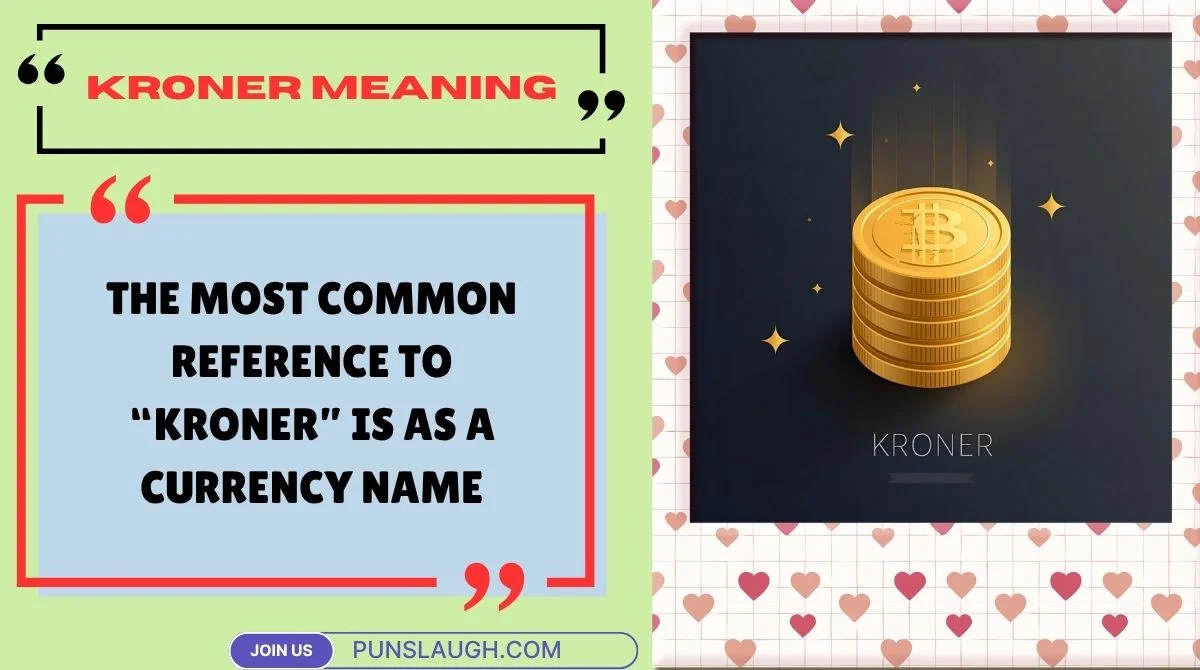The word “Kroner” is more than just a unit of money. It carries centuries of history, cultural meaning, and modern relevance.
Whether you’ve seen it in a financial headline, heard it in a movie, or encountered it in slang, understanding the term gives you insight into Nordic economies and global trade.
This guide breaks down Kroner meaning in detail—covering its use in currency, language, slang, pop culture, history, and even in technical contexts.
Kroner Meaning in Currency
The most common reference to “Kroner” is as a currency name. The word comes from the Scandinavian word Krone, which means “crown.”
The plural form is Kroner in Danish and Norwegian. Historically, crowns were symbols of sovereignty and value, so many European countries named their currencies after them.
Two countries still use Kroner as their official currency: Norway and Denmark.
Norwegian Kroner (NOK)
The Norwegian Kroner (NOK) is the official currency of Norway.
Key Facts About NOK
- Currency code: NOK
- Symbol: kr
- Introduced: 1875, replacing the Norwegian speciedaler
- Issuing authority: Norges Bank (Central Bank of Norway)
- Subunit: 1 NOK = 100 øre (though øre coins are no longer in circulation)
A Brief History
Norway adopted the Kroner when it joined the Scandinavian Monetary Union in 1875. This union tied the Danish, Norwegian, and Swedish currencies to gold, making trade and exchange smoother across Scandinavia.
When the union dissolved in 1914, Norway kept the Kroner. Over the decades, its value has shifted due to oil discoveries, global market trends, and monetary policies.
Modern Use
Today, NOK is a free-floating currency, meaning its value is determined by market forces. It’s widely traded due to Norway’s strong economy, especially its oil and gas exports.
NOK Exchange Rates (October 2025 example)
| Currency | 1 NOK Equals |
|---|---|
| USD | 0.092 USD |
| EUR | 0.087 EUR |
| GBP | 0.074 GBP |
Note: Exchange rates fluctuate daily based on market conditions.
Danish Kroner (DKK)
The Danish Kroner (DKK) is the currency of Denmark and its territories, including Greenland and the Faroe Islands.
Key Facts About DKK
- Currency code: DKK
- Symbol: kr
- Introduced: 1875 (like Norway, during the Scandinavian Monetary Union)
- Issuing authority: Danmarks Nationalbank
- Subunit: 1 DKK = 100 øre
Economic Context
Unlike Norway, Denmark has chosen to peg the Kroner to the Euro. This means the Danish Kroner maintains a fixed exchange rate with the Euro under the European Exchange Rate Mechanism (ERM II).
This policy helps stabilize trade with EU countries while allowing Denmark to retain its national currency instead of adopting the Euro.
DKK Exchange Rates (October 2025 example)
| Currency | 1 DKK Equals |
|---|---|
| USD | 0.14 USD |
| EUR | 0.13 EUR |
| GBP | 0.11 GBP |
Norwegian Kroner vs Danish Kroner
Although both currencies share the same name and historical roots, they differ in several important ways.
| Feature | Norwegian Kroner (NOK) | Danish Kroner (DKK) |
|---|---|---|
| Country | Norway | Denmark |
| Currency Code | NOK | DKK |
| Exchange Policy | Free-floating | Pegged to Euro |
| Main Economic Driver | Oil, energy exports | Trade with EU |
| Stability | More volatile | More stable due to peg |
| Introduced | 1875 | 1875 |
Key takeaway:
- Travelers and investors often see NOK as more exposed to global oil prices.
- DKK is relatively stable because of its Euro peg.
Kroner vs Euro
You might wonder why Norway and Denmark, both European countries, still use Kroner instead of the Euro.
Main Reasons
- Norway: Not part of the EU, prefers to maintain independent monetary policies.
- Denmark: Member of the EU but negotiated an opt-out clause during the Maastricht Treaty.
Impact on Travelers and Investors
- Currency exchange is required when visiting or trading with Norway or Denmark.
- Fluctuations in NOK can present opportunities or risks for investors.
- DKK’s Euro peg makes it predictable for EU-related trade.
Kroner Meaning in English
In plain English, “Kroner” means “crowns.” This reflects the monarchic heritage of Scandinavian countries.
For example:
- Norwegian Kroner → Norwegian crowns
- Danish Kroner → Danish crowns
In English-language newspapers and financial reports, you’ll often see Kroner written simply as “kr” followed by the amount.
Kroner in English Slang
Occasionally, “Kroner” pops up in English-speaking communities in playful or slang contexts. Most slang usage comes from:
- Online gaming communities referencing in-game currency.
- Humor related to Nordic themes in memes or forums.
However, it’s worth noting that this is niche slang and not as widespread as mainstream slang terms.
Slang Origin and Cultural References
In online spaces like Urban Dictionary, “Kroner” sometimes refers jokingly to:
- Money in general (like saying “bucks”).
- Scandinavian heritage in memes.
These meanings aren’t official or widely recognized in dictionaries, but they show how language evolves in digital culture.
Kroner in Pop Culture
The word Kroner has appeared in films, TV shows, and literature, especially those set in Nordic countries.
Examples
- In Scandinavian noir series, Kroner often symbolizes local authenticity.
- Films about WWII or Nordic history frequently show Kroner notes and coins as props.
Kroner as a Name or Symbol
In some fictional stories, Kroner is used as:
- A surname for Nordic characters.
- A metaphor for wealth, heritage, or royal lineage.
These cultural references keep the term recognizable even outside of financial contexts.
Kroner in Specialized Contexts
Technical or Electrical Context
There is no standard technical or electrical term named Kroner.
Any mention you encounter likely refers to a company name or is a misspelling of another term.
Kroner in Regional Languages
The word “Kroner” is used differently across languages:
- Norwegian: Kroner (plural of Krone)
- Danish: Kroner (plural of Krone)
- Swedish: Uses “Krona” (plural “Kronor”)
- Hindi: क्रोनर (pronounced “Kronar”)
In global trade platforms, the English transliteration “Kroner” is widely accepted.
History of Kroner
The Kroner traces its roots back to the 19th century, a time when many European nations named their currencies after royal crowns.
Timeline Highlights
- 1873: Formation of the Scandinavian Monetary Union by Denmark and Sweden.
- 1875: Norway joins the union and adopts the Kroner.
- 1914: Union dissolves; countries keep their own versions of Kroner.
- 20th Century: Kroner adapts to modern monetary systems, moving away from gold standards.
This history shows how a single term became central to Nordic identity and finance.
Kroner Exchange Rates and Value
The value of both NOK and DKK has shifted significantly over time.
Key Influences
- NOK: Strongly affected by oil prices and global energy demand.
- DKK: Influenced by Eurozone policies because of its currency peg.
Historical Trends
- NOK strengthened during the oil boom in the 1970s–1980s.
- DKK maintained relative stability due to its link with European trade.
For businesses and travelers, staying updated on exchange rates is crucial.
Kroner Connections
Beyond finance, the term “Kroner” shows up in:
- Company names, especially in Scandinavia.
- Art and design, symbolizing Nordic tradition.
- Cultural references where crowns symbolize value and prestige.
FAQs About Kroner
What does Kroner literally mean?
Kroner literally means “crowns” and originates from monarchic Europe.
Is Kroner still widely used?
Yes. Both Norway and Denmark use their national versions of Kroner today.
How does Kroner differ from Krone?
“Krone” is the singular form; “Kroner” is plural.
Why don’t Norway and Denmark use the Euro?
Norway isn’t in the EU, and Denmark opted out to maintain currency independence.
How stable is the Kroner compared to other currencies?
DKK is highly stable due to its Euro peg. NOK fluctuates more because of oil prices and market dynamics.
Conclusion
The word “Kroner” represents far more than a price tag. It links back to Europe’s royal history, highlights the economic independence of Norway and Denmark, and continues to shape modern trade, travel, and culture.
Whether you’re a traveler converting currency, an investor watching Nordic markets, or simply curious about the word’s roots, understanding Kroner meaning gives you insight into both history and the global economy.





